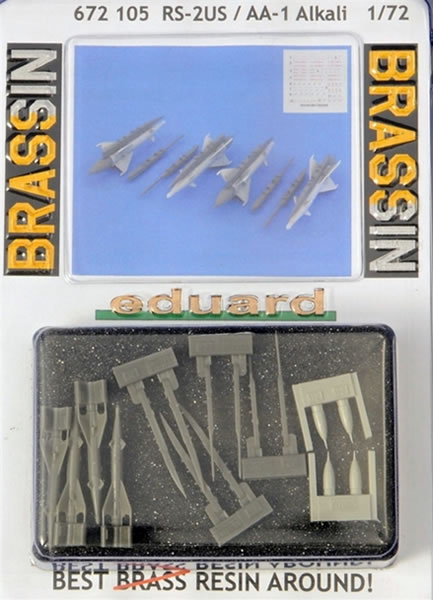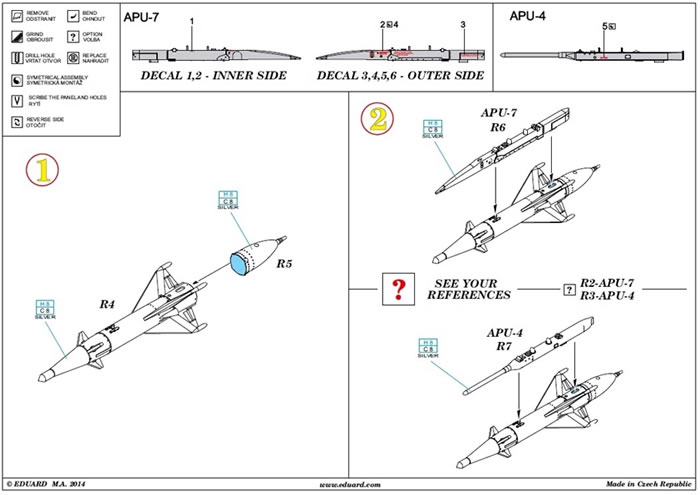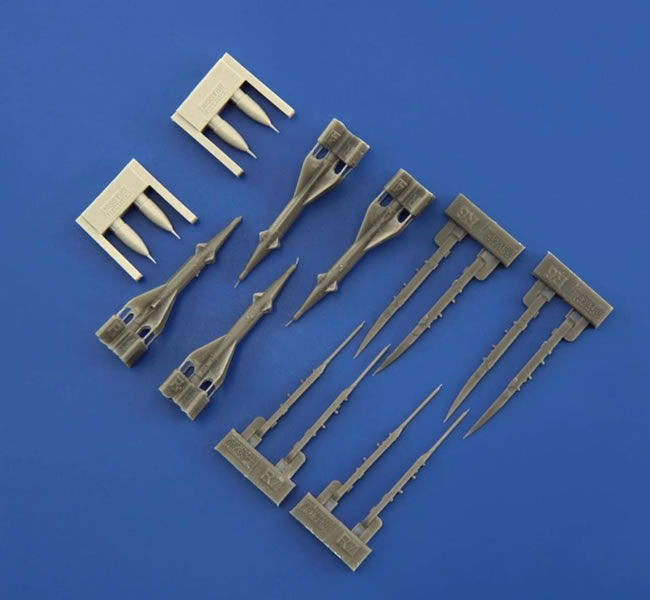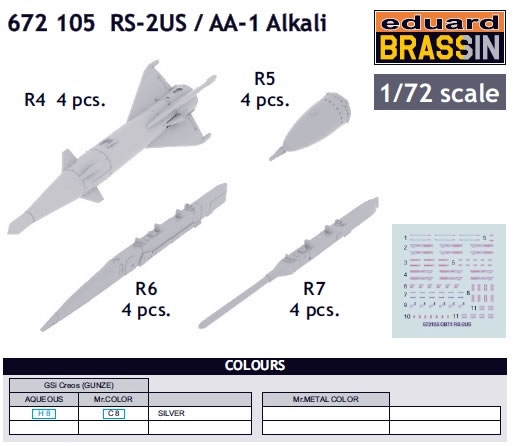RS-2US / AA-1 Alkali

Eduard BRASSIN, 1/72 scale
S u m m a r y : |
Catalogue Number: |
Eduard Item No. 672 105 - RS-2US / AA-1 Alkali |
Scale: |
1/72 |
Contents & Media |
Sixteen resin parts and decals. |
Price: |
Available online from these stockists:
|
Review Type: |
First Look. |
Advantages: |
Superb quality, choice of launch rails included. |
Disadvantages: |
None noted. |
Conclusions: |
Eduard Brassin’s Alkali missiles are very nicely rendered, and represent an excellent complement suitable fighter subjects from the Soviet-bloc. The inclusion and choice of launch rails is a nice bonus.
Definitely recommended. |
Reviewed by Mark Davies

Eduard's 1/72 Alkali Missiles are available online from Squadron.com
The Kaliningrad K-5 (NATO reporting name AA-1 Alkali) was an early Soviet air-to-air missile, also known as the RS-1U or product ShM.
The development of the K-5 began in 1951. The first test firings were in 1955. It was tested (but not operationally carried) by the Yakovlev Yak-25. The weapon entered service as the Grushin/Tomashevich RS-2U (also known as the R-5MS or K-5MS) in 1957. The initial version was matched to the RP-2U (Izumrud-2) radar used on the MiG-17PFU, MiG-19PM. An improved variant entered production in 1959, and was known as the K-5M or RS-2US in PVO service. This was matched to the RP-9/RP-9U (Sapfir) radar of the Sukhoi Su-9. The People's Republic of China developed a copy under the designation PL-1, for use by their J-6B fighters.
The difficulties associated with beam-riding guidance, particularly in a single-seat fighter aircraft, were substantial, making the 'Alkali' primarily a short-range anti-bomber missile. Around 1967 the K-5 was replaced by the K-55 (R-55 in service), which replaced the beam-riding seeker with the semi-active radar homing or infrared seekers of the K-13 (AA-2 'Atoll'). The weapon was 7.8 kg (17 lb) heavier than the K-5, but had a smaller 9.1 kg (20 lb) warhead. The K-55 remained in service through about 1977, probably being retired with the last of the Sukhoi Su-9 interceptors.
Source: Wikipedia
I can think of some kits I have seen with injected examples of the Alkali that look like blobs with great thick fins. It is therefore pleasing that Eduard has produced a refined set of four Alkali missiles complete with a choice of launch rails. This is the first time I can recall this missile being offered as an aftermarket accessory, although I possibly Dragon included injected examples in one of their weapons sets.
The four missiles come attractively packaged in a blister pack with sponge cushioning.

Very clear instructions are included, downloadable as a PDF from Eduard’s website, with colour call-outs cross-referenced to the Gunze Aqueous and Mr Color paint ranges. A small sheet of decals provides the missile markings.

The quality of casting is excellent, with the pour subs attached to the tail fins.

Because of this, the cone shaped after-bodies, which I assume these were a frangible fairing over the rocket motor for streamlining on the real missile, are cast separately. A choice of APU-4 or APU-7 launch rails is provided to suit different aircraft types.

Painted and decaled, these Alkali missiles should be a vast improvement over any injected kit items.
Eduard’s website advises that they are a suitable compliment to these aircraft (number of missiles carried shown in brackets):
-
MiG-21PF (x2),
-
MiG-21PFM (x2),
-
MiG-21R (x2),
-
MiG-21S (x4),
-
Su-9 (x4), and
-
Su-9U (x2).
Eduard offers a very similar 1/48 scale set of four Alkali missiles (Brassin 648 040), but with separate forward fins and wingtip cone-shaped fairings, for US$14.95. Quarter-scalers also have the option of an Alkali service cart complete with six missiles for US$29.95 (Brassin 648 045)
Eduard Brassin’s Alkali missiles are very nicely rendered, and represent an excellent complement suitable fighter subjects from the Soviet-bloc. The inclusion and choice of launch rails is a nice bonus.
Definitely recommended.
Thanks to Eduard for the samples and images.
Review Text & Images Copyright © 2016 by Mark Davies
Page Created 13 September,, 2016
Last updated
13 September, 2016
Back to HyperScale Main Page
Back to Reviews Page

|
